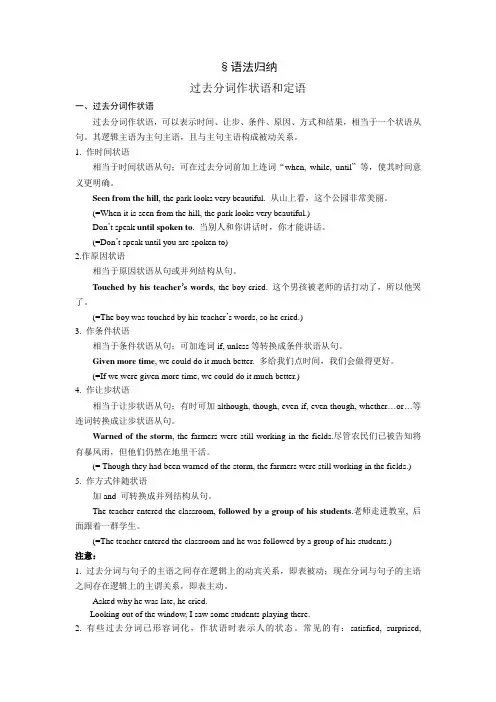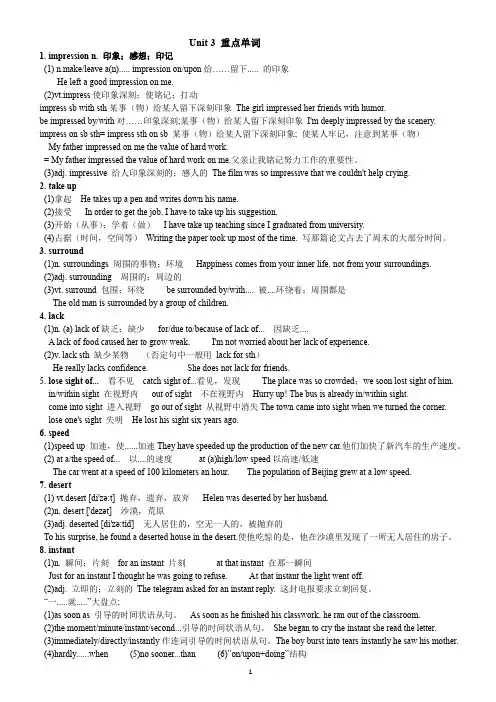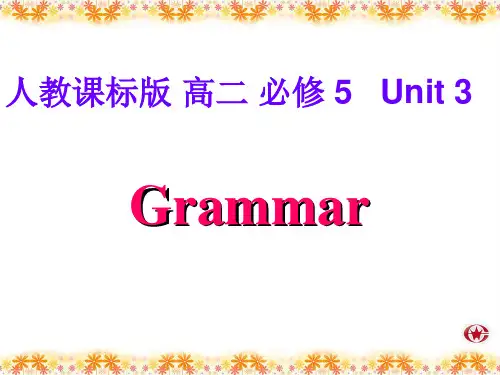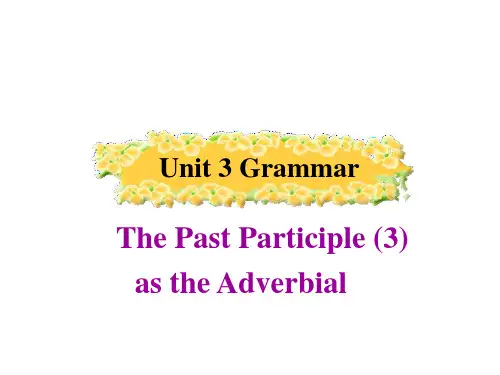Unit 3 过去分词作状语
人教版必修5unit3过去分词作状语

Moving /pleaseing/dispointing/worrying
be dressed in
be seated
be lost in沉浸在
be prepared for
be devoted to 致力于 be determined to do
be supposed to 应该 be absorbed in
过去分词作状语与现在分词作状语的区别
有些过去分词(短语)源于系表结构,作
状语时不表动作而表状态。
moved/pleased/disappointed/worried…
Moving /pleaseing/dispointing/worrying
What is the name of the building?
['ɑdəsi] n. 奥德赛(古希腊史诗)
Lines of a Chinese movie:
《G大iv话en西an游ot》her chance by God, I will
say to the girl, “I love you.” If there
莫言站在那儿被记着围住。 Moyan stood there , surrounded by many
reporters
那个老人在他的妻子的搀扶下在公园中散 步。(support)
The old man walked in the park, _s_u_p_p_o_r_t_ed__b_y__h_is__w_i_fe_.
7.If he is given time,he’ll make a first-class tennis player. →__G_i_v_e_n_t_im__e__,he’ll make a first-class tennis player. 8.He stood there silently,and he was moved to tears. →He stood there silently,_m__o_v_e_d_t_o__te_a_r_s_______.
人教版高中英语:Unit 3 Life in the future 语法归纳 过去分词作状语和定语

§语法归纳过去分词作状语和定语一、过去分词作状语过去分词作状语,可以表示时间、让步、条件、原因、方式和结果,相当于一个状语从句。
其逻辑主语为主句主语,且与主句主语构成被动关系。
1. 作时间状语相当于时间状语从句;可在过去分词前加上连词“when, while, until”等,使其时间意义更明确。
Seen from the hill, the park looks very beautiful. 从山上看,这个公园非常美丽。
(=When it is seen from the hill, the park looks very beautiful.)Don’t speak until spoken to. 当别人和你讲话时,你才能讲话。
(=Don’t speak until you are spoken to)2.作原因状语相当于原因状语从句或并列结构从句。
Touched by his teacher’s words, the boy cried. 这个男孩被老师的话打动了,所以他哭了。
(=The boy was touched by his teacher’s words, so he cried.)3. 作条件状语相当于条件状语从句;可加连词if, unless等转换成条件状语从句。
Given more time, we could do it much better. 多给我们点时间,我们会做得更好。
(=If we were given more time, we could do it much better.)4. 作让步状语相当于让步状语从句;有时可加although, though, even if, even though, whether…or…等连词转换成让步状语从句。
Warned of the storm, the farmers were still working in the fields.尽管农民们已被告知将有暴风雨,但他们仍然在地里干活。
必修5 Unit 3 单词语法 过去分词做状语及练习题

Unit 3 重点单词1. impression n. 印象;感想;印记(1) n.make/leave a(n)..... impression on/upon给……留下..... 的印象He left a good impression on me.(2)vt.impress使印象深刻;使铭记;打动impress sb with sth某事(物)给某人留下深刻印象The girl impressed her friends with humor.be impressed by/with对……印象深刻;某事(物)给某人留下深刻印象I'm deeply impressed by the scenery. impress on sb sth= impress sth on sb 某事(物)给某人留下深刻印象; 使某人牢记,注意到某事(物)My father impressed on me the value of hard work.= My father impressed the value of hard work on me.父亲让我铭记努力工作的重要性。
(3)adj. impressive 给人印象深刻的;感人的The film was so impressive that we couldn't help crying.2.take up(1)拿起He takes up a pen and writes down his name.(2)接受In order to get the job, I have to take up his suggestion.(3)开始(从事);学着(做)I have take up teaching since I graduated from university.(4)占据(时间,空间等)Writing the paper took up most of the time. 写那篇论文占去了周末的大部分时间。
过去分词作状语

Grammar
.过去分词(短语)作状语的功能 及位置:
(1)功能: 过去分词作状语,修饰谓语动词,进一步说 明谓语动词的动作和状态,即动作发生时 的背景或状况,其逻辑主语通常就是句子 的主语,且主语是过去分词动作的承受者; 过去分词与主语之间是动宾关系,即被动 关系。
注意: 如果被修饰的词是由 every/some/any/no + thing/body/one 所构成的复合代词或指示代词those等时, 即使一个单一的分词作形容词用,也要放 在被修饰词的后面。 例如: Is there anything unsolved? There is noting changed here since I left this town.
(2)过去分词(短语)作条件、原因、时 间、让步状语时,通常放在句首;作伴随、 结果、方式状语时,一般放在句末。 Given more time, he can do it better.
过去分词(短语)作状语分类:
(1)作时间状语: 可以转换为when,while,once, 或after等引导的状语从句。 Seen from the top of the hill, our city looks beautiful. =When it is seen from the top of the hill, our city looks beautiful.
(8) 以下几个词应注意: speaking,judging作悬垂状语时,不需和句 子主语保持一致。 Generally speaking, women live longer than men. Judging by her look, she was disappointed.
新编实用英语综合教程1 Unit 3

Follow the Samples
Sample 2 Tom is introducing Mr. Brown to Dr. Terry.
Tom: Mr. Brown, I’d like you to meet Dr. Patrick Terry. Mr. Brown: How do you do? Dr. Terry: How do you do? Tom: Dr. Terry is an economist. He just finished writing a book on North America and WTO. Mr. Brown: Oh? Do you work in the Finance Department, Chicago University, by any chance? Dr. Terry: Yes. How did you guess? Mr. Brown: I’ve read your another book on economic reform of Canada. It’s excellent.
Useful Sentences and Expressions
Follow the Samples
Introducing
Sample 1 Mr. Smith is waiting at an International Airport for his son’s best friend, Jack, who comes to China for traveling for the firs time from Spain.
Follow the Samples
Sample1 Mr. Smith: Not at all. I heard a lot about you from Joe. I know you are good friends. Jack: Yes. We work in the same department and have a lot in common. Many colleagues say that we are like brothers. Mr. Smith: I’m so happy to hear that. And shall we go now? My car’s just outside the airport. My wife is waiting for us at home. Jack: Sure. Thank you so much
必修五Unit3 period3 Grammar过去分词作状语

过去分词作状语, 表示被动的动作或动作 已经完成。过去分词(短语)通常可作:
1. 时间状语 时间状语可在过去分词前加上连词when, while, until等。 When it is seen from the hill, the park looks very beautiful.
Seen from the hill…
5. If I am compared with you, we still have a long way to go. Compared with you, we still have a long way to go.
6 The hunter left his house, and he was followed by his dog.
The hunter left his house, followed by his dog.
Rewrite with proper conjunctions
Example:
1. United we stand, divided we fail. If we are united, we will stand, but if we are divided, we will fail.
Unit 3 Grammar
The Past Participle (3) as the Adverbial
在前两个单元我们讲解了动 词的-ed形式作什么呢?
作定语和表语 作宾语补足语来自本单元我们将继续学习动词 的-ed形式作句子中的另一种 成分。 动词的-ed形式作状语
观察下列句子:
Once published, his works (=Once his works was published, ) became famous for the absence of rhyme at the end of each line. PP作时间状语, 相当于一个时间状语 从句。有时过去分词前可加连词when 或while来强调时间概念。
Unit3(M)v-ed过去分词
条件
比较doing(现在分词)作状语
V-ing 可以用作时间,原因,结果,伴随/方式,条件状语
Walking through the park, I saw lovely roses. Knowing the language well, he translated the article without difficulty. Having time, he will help you. Our car broke down on the way, causing the delay. 主语一致 He got home, feeling very tired. 主动关系
(二) done作宾补
done作宾补
V+宾语+done:过去分词与宾语间是被动关系 1. You should keep them informed of what is going on here. 2.He got up very late, and therefore left his breakfast unfinished. 3.I heard my names called just now. 4. He spoke slowly to make himself understood. 5.I wanted things (to be) done in this way.
Attention: puzzled The ______(puzzle) look on his face showed that he didn’t understand. The room having been painted is for us. Right or wrong? Wrong! The room painted is for us. Compare: The room being painted is for us. The room ____________(paint) next to be painted week is for our teacher.
Book5 Unit3 过去分词短语作状语
1) Charles Dickens is a famous British novelist. 2) He was born into a poor family. 3) He received little school education.
= Working harder at English, you’ll make … 现在 分词 如果句子的主语与分词是主动关系,用_____ 过去 分词 如果句子的主语与分词是被动关系,用_____
Practice 1:
Difference between the Present Participle and the Past Participle Used _____for a long time, the book looks old. 由于用了很长时间,这本书看上去很旧。 Using the book, I find it useful. ______ 在使用的过程中,我发现这本书很有用。 Looking _______(look) at her, he jumped with joy. _______(look) at by her, he jumped with joy. Looked
Let’s write a short passage!
2. 自我介绍:李华 1) 一个17岁的中国男孩 2) 目前(currently)在一所重点中学读书 1) I am Li Hua. 2) I am a 17-year-old boy. 3) I currently study in a key middle school.
牛津高中英语模块五Unit 3 过去分词与形容词作状语讲解与练习
模块五Unit 3 过去分词与形容词作状语讲解与练习2011/10/18一、过去分词的特征1.及物动词的过去分词既表被动,也表完成。
The books, written by Lu Xun(=which were written by Lu Xun), are popular with many Chinese people.鲁迅写的这些书,受到了许多国人的喜爱。
2.不及物动词的过去分词只表完成,不表被动。
The boy is gathering fallen leaves(=leaves that have fallen).小男孩正在收集落叶。
二、过去分词的句法功能过去分词一方面具有动词的性质,另一方面也相当于一个形容词或副词,在句中可以作表语、定语、状语和补足语。
1.作表语。
过去分词作表语,主要表示主语的心理感觉或所处的状态。
He is quite pleased with the design of the dress.他很喜欢那礼服的式样。
(表示主语的心理感觉) Don’t touch the glass because it is broken.不要碰那个杯子,它是坏的。
(表示主语所处的状态) The shops have remained shut for a week.这些商店关门一周了。
【点津】过去分词作表语时,形式上和动词的被动语态结构相似,但两者表达的意义不同。
由过去分词作表语构成的系表结构强调主语的特点或所处的状态,构成被动语态的过去分词.则强调动作。
The book is well written.这本书写得很好。
(系表结构,表示主语的特点)The book was written by Lu Xun.这本书是鲁迅写的。
(被动结构,表示动作)2.作定语。
单个过去分词作定语常放在被修饰词的前面,过去分词短语放在被修饰词的后面。
polluted water 被污染的水a broken glass 一个被打破的玻璃杯a trained nurse 一名训练有素的护士the risen sun 升起了的太阳We only sell used books in our bookstore.我们书店只卖用过的书。
unit 3 life in the future grammar 过去分词作状语
was followed by his dog.
2. She sat by the window, lost in thought.
→She sat by the window, and she
was lost in thought.
lost 表示一种迷失心理状态
Summary
1) 过去分词在句子中可以作时间状语、 条件状语、原因状语、让步状语、
3. If given more time, we would be able to do the work much better. → If we were given more time, we would be able to do the work much better. 4. Once translated into Chinese, the book became very popular among Chinese teenagers. →Once it was translated into Chinese, the book became very popular among Chinese teenagers.
伴随状语等。
2) 过去分词作状语时,过去分词的逻辑
主语就是主句的主语,与主语之间
存在被动关系。
A.用过去分词作状语来改out the journey, I was unsettled for the first few days. Worried about the journey , I was → _______________________ unsettled for the first few days.
2. If we are compared with(与…相比)
- 1、下载文档前请自行甄别文档内容的完整性,平台不提供额外的编辑、内容补充、找答案等附加服务。
- 2、"仅部分预览"的文档,不可在线预览部分如存在完整性等问题,可反馈申请退款(可完整预览的文档不适用该条件!)。
- 3、如文档侵犯您的权益,请联系客服反馈,我们会尽快为您处理(人工客服工作时间:9:00-18:30)。
分词作状语答题记忆口诀
分词作状语,主语是问题。 逗号前后两动作,共用一主语。 主语找出后,再来判关系。 主动-ing,被动用-ed。 Having been done 表先后, 千万要牢记。
Practice
1. 用所给词的适当形式填空,并与A-C的汉语翻译相匹配。
cry. ( 时间 )
When asked why he didn’t do it, hgiven more time, I’ll catch up with you.( 条件 ) Given more time, I’ll catch up with you.
3. Because he was born and brought up in the village, he knows a lot of people there.(原因 ) Born and brought up in the village, he knows a lot of people there.
city looks more beautiful. (see)
Seeing from the top of the tower, we can
get a wonderful view of our city.(see)
To get a wonderful view of our city, we
climbed to the top of the tower.(get)
因为沉浸在思考之中,所以他没听到那个声音。
4. 现在分词、过去分词和不定式作状语的区别
1)V-ing作状语时,分词表示的动作与句子主语之间
构成主动关系。
2)V-ed作状语时,分词表示的动作与句子主语之间
构成被动关系。
3)to do/be done作状语,一般表示目的。
Seen
from the top of the tower, our
Unit 3 Life in the future
Grammar The Past Participle used as Adverbial
过去分词作状语
1.Discovering useful structures: Fill in the blanks.
Arriving in the city in AD 3008, Li Qiang felt___w_o_r_r_ie_d__ (wo表rry语) and unsettled at first, as a result he suffered from time lag. ___C__on_f_u_s_ed__ (co状nf语use) by the new surroundings, Li Qiang was hit by the lack of fresh air and his head ached. He had a宾m补ask ___p_u_t ___(put) on. Then he felt better. After that they took a hovering carriage ___d_ri_v_e_n__ (dr定iv语e) by computer to a market. Arriving home Li Qiang was ___s_h_ow__e_d_ (show) into a large bright, clean room with a green wall, a brown floor and soft lighting. ___E_x_h_a_u_st_e_d__ (e状xh语aust), he slid into bed and fell fast asleep.
Asked why she was late, she went red in the
face.
√
2. 小偷如果被抓,会受到警方的惩罚。
If caught, the police will punish the thief. ×
If caught, the thief will be punished by the
generally(frankly/exactly/…./ )speaking 一般地(坦率地/确切地)说;
considering(考虑到)……; talking of(说到)….; supposing that(假使)….; given… (倘若……;假定……) provided/providing (that)… 假如,倘若… seeing that(鉴于)…..等。
Seen from the space, our future school looks like a plate.
our future classroom
Lily’s classroom
2. As Lily’s classroom is surrounded by water, Lily’s classroom looks beautiful.
1. Dressed in white, the bride looks more beautiful.
穿着一身白色衣服,新娘看起来更漂亮
2. Tired of listening to music, she began to watch TV.
由于听累了音乐,他开始看电视。
3. Absorbed in deep thought, he didn’t hear the sound.
summary
过去分词作状语要点
1.过去分词作状语表示_被__动__/或__完__成__的动作, 相当一个状语从句。
2.过去分词作状语时其逻辑主语与主句的主语 要保持一致。
3.过去分词在句子中可以作时间状语、原因状 语、伴随状语、条件状语和让步状语等。
句型转换: (练习卷) 1. When he was asked why he didn’t do it, he began to
The teacher stood there, surrounded by the students.
•重难点辨析
1. 过去分词的逻辑主语和句子的主语要保持一致 1. 当被问到为什么迟到时,她的脸涨得通红。
Asked why she was late, her face went re×d.
1. Well-known for their expertise, his parents’ company transported me safely into the future in a time capsule.
As his parents’ company was well-known for their expertise, his parents’ company transported me safely into the future in a time capsule.
3.过去分词作状语时不表被动或完成意义的情况
有些过去分词已形容词化,来源于系表结构, 作状语时已无被动或完成意义。如: (be) lost in 沉湎于 (be) seated 坐 (be) born 出身于 (be) dressed in 穿着 (be) interested in 感兴趣 (be) tired of 厌烦 (be) worried about 担心 (be) faced with 面临
play football.
(独立主格结构)
Having finished their homework, the children went
out to play football. (现在分词完成形式)
With their homework finshed, the children went out
police.
√
2. 过去分词的独立主格结构
分词作状语时, 如果其逻辑主语与整个句子 的主语不一致时,需要独立主格结构或 with 复合结构来替代。
(1) The signal given, the bus started.
信号一发出,汽车就开动了。
(the signal 是 given 的逻辑主语,因此主句 主语 the bus 就不是given 的逻辑主语。) (2) She went by with her head held high .
3.Given good weather, our ship will reach Shanghai this evening.
假如天气好,我们的船将于今晚抵达上海。
4.Considering his health, he was made to stay at home。
考虑到他的健康状况,他被迫呆在家里。
to play football. (with的复合结构)
After finishing their homework, the children went
out to play football.
(介词+动名词)
★有些含有分词的固定插入语, 其逻辑主语不 要求与主语一致。如:
judging from(从…….来判断);
4. Although they had been defeated many times, they continued to fight. ( 让步 )
Although defeated many times, they continued to fight.
5. The teacher stood there, and was surrounded by the students. ( 伴随 )
Try to rewrite the sentences from the passage with past participles used as the adverbial.
Look at P21/ Ex.1 Turn the adverbial structure
